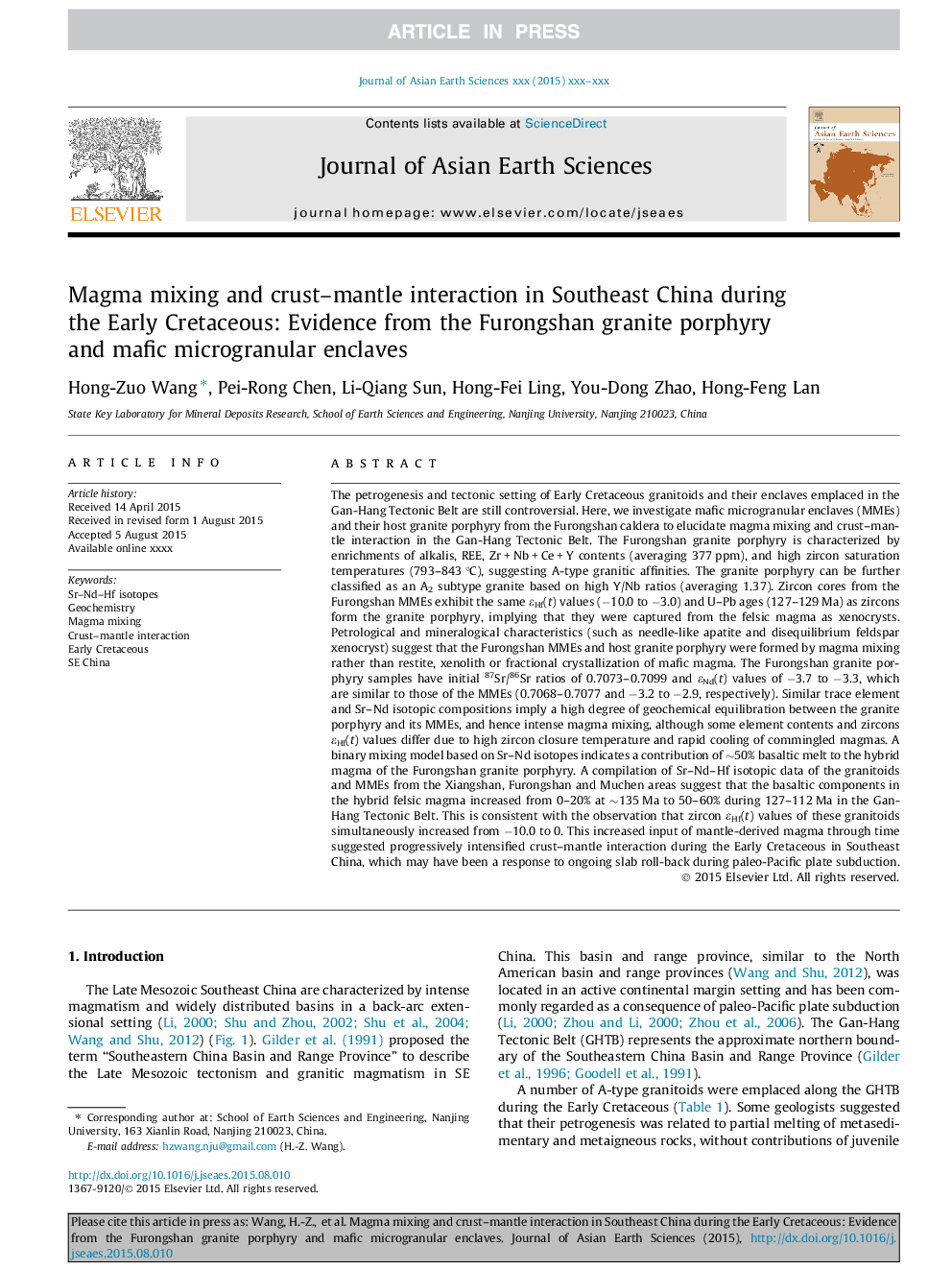| کد مقاله | کد نشریه | سال انتشار | مقاله انگلیسی | نسخه تمام متن |
|---|---|---|---|---|
| 6444124 | 1640358 | 2015 | 16 صفحه PDF | دانلود رایگان |
عنوان انگلیسی مقاله ISI
Magma mixing and crust-mantle interaction in Southeast China during the Early Cretaceous: Evidence from the Furongshan granite porphyry and mafic microgranular enclaves
دانلود مقاله + سفارش ترجمه
دانلود مقاله ISI انگلیسی
رایگان برای ایرانیان
کلمات کلیدی
موضوعات مرتبط
مهندسی و علوم پایه
علوم زمین و سیارات
زمین شناسی
پیش نمایش صفحه اول مقاله

چکیده انگلیسی
The petrogenesis and tectonic setting of Early Cretaceous granitoids and their enclaves emplaced in the Gan-Hang Tectonic Belt are still controversial. Here, we investigate mafic microgranular enclaves (MMEs) and their host granite porphyry from the Furongshan caldera to elucidate magma mixing and crust-mantle interaction in the Gan-Hang Tectonic Belt. The Furongshan granite porphyry is characterized by enrichments of alkalis, REE, Zr + Nb + Ce + Y contents (averaging 377 ppm), and high zircon saturation temperatures (793-843 °C), suggesting A-type granitic affinities. The granite porphyry can be further classified as an A2 subtype granite based on high Y/Nb ratios (averaging 1.37). Zircon cores from the Furongshan MMEs exhibit the same εHf(t) values (â10.0 to â3.0) and U-Pb ages (127-129 Ma) as zircons form the granite porphyry, implying that they were captured from the felsic magma as xenocrysts. Petrological and mineralogical characteristics (such as needle-like apatite and disequilibrium feldspar xenocryst) suggest that the Furongshan MMEs and host granite porphyry were formed by magma mixing rather than restite, xenolith or fractional crystallization of mafic magma. The Furongshan granite porphyry samples have initial 87Sr/86Sr ratios of 0.7073-0.7099 and εNd(t) values of â3.7 to â3.3, which are similar to those of the MMEs (0.7068-0.7077 and â3.2 to â2.9, respectively). Similar trace element and Sr-Nd isotopic compositions imply a high degree of geochemical equilibration between the granite porphyry and its MMEs, and hence intense magma mixing, although some element contents and zircons εHf(t) values differ due to high zircon closure temperature and rapid cooling of commingled magmas. A binary mixing model based on Sr-Nd isotopes indicates a contribution of â¼50% basaltic melt to the hybrid magma of the Furongshan granite porphyry. A compilation of Sr-Nd-Hf isotopic data of the granitoids and MMEs from the Xiangshan, Furongshan and Muchen areas suggest that the basaltic components in the hybrid felsic magma increased from 0-20% at â¼135 Ma to 50-60% during 127-112 Ma in the Gan-Hang Tectonic Belt. This is consistent with the observation that zircon εHf(t) values of these granitoids simultaneously increased from â10.0 to 0. This increased input of mantle-derived magma through time suggested progressively intensified crust-mantle interaction during the Early Cretaceous in Southeast China, which may have been a response to ongoing slab roll-back during paleo-Pacific plate subduction.
ناشر
Database: Elsevier - ScienceDirect (ساینس دایرکت)
Journal: Journal of Asian Earth Sciences - Volume 111, 1 November 2015, Pages 72-87
Journal: Journal of Asian Earth Sciences - Volume 111, 1 November 2015, Pages 72-87
نویسندگان
Hong-Zuo Wang, Pei-Rong Chen, Li-Qiang Sun, Hong-Fei Ling, You-Dong Zhao, Hong-Feng Lan,